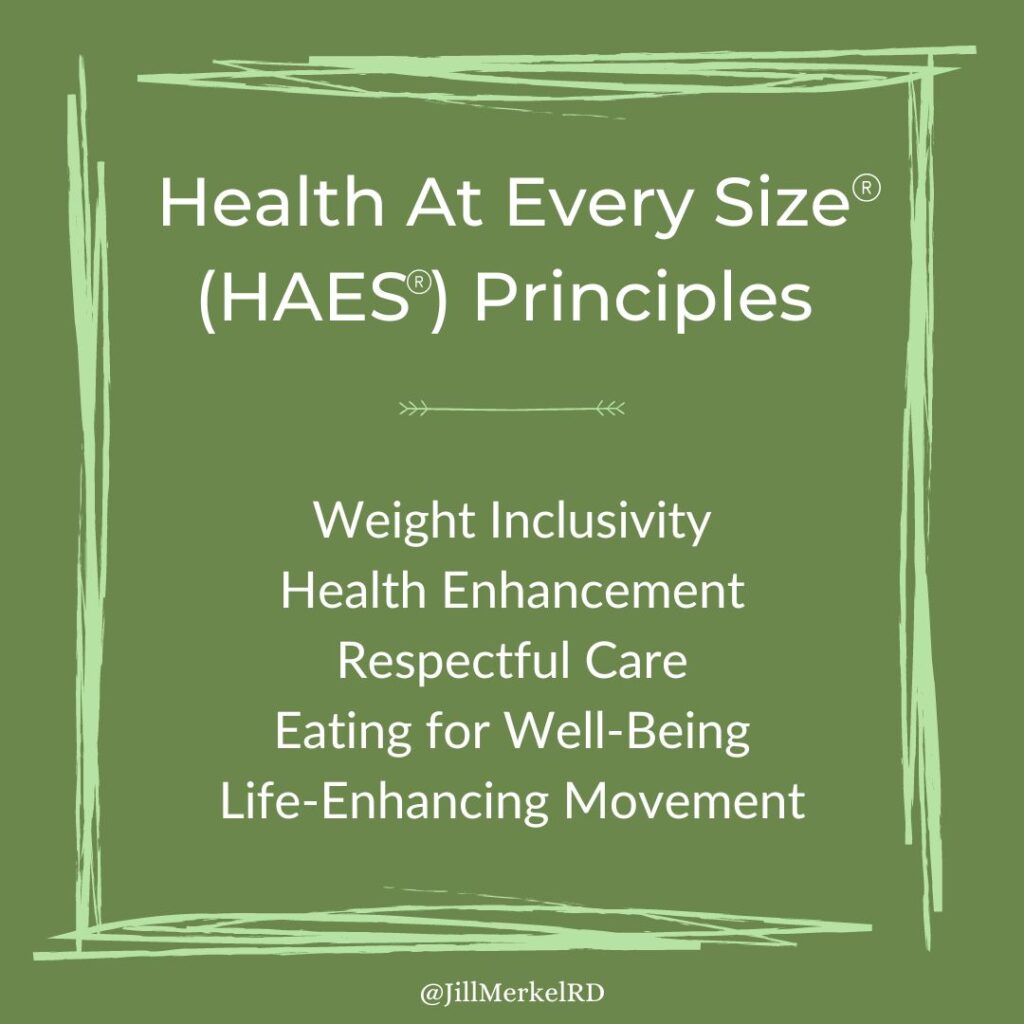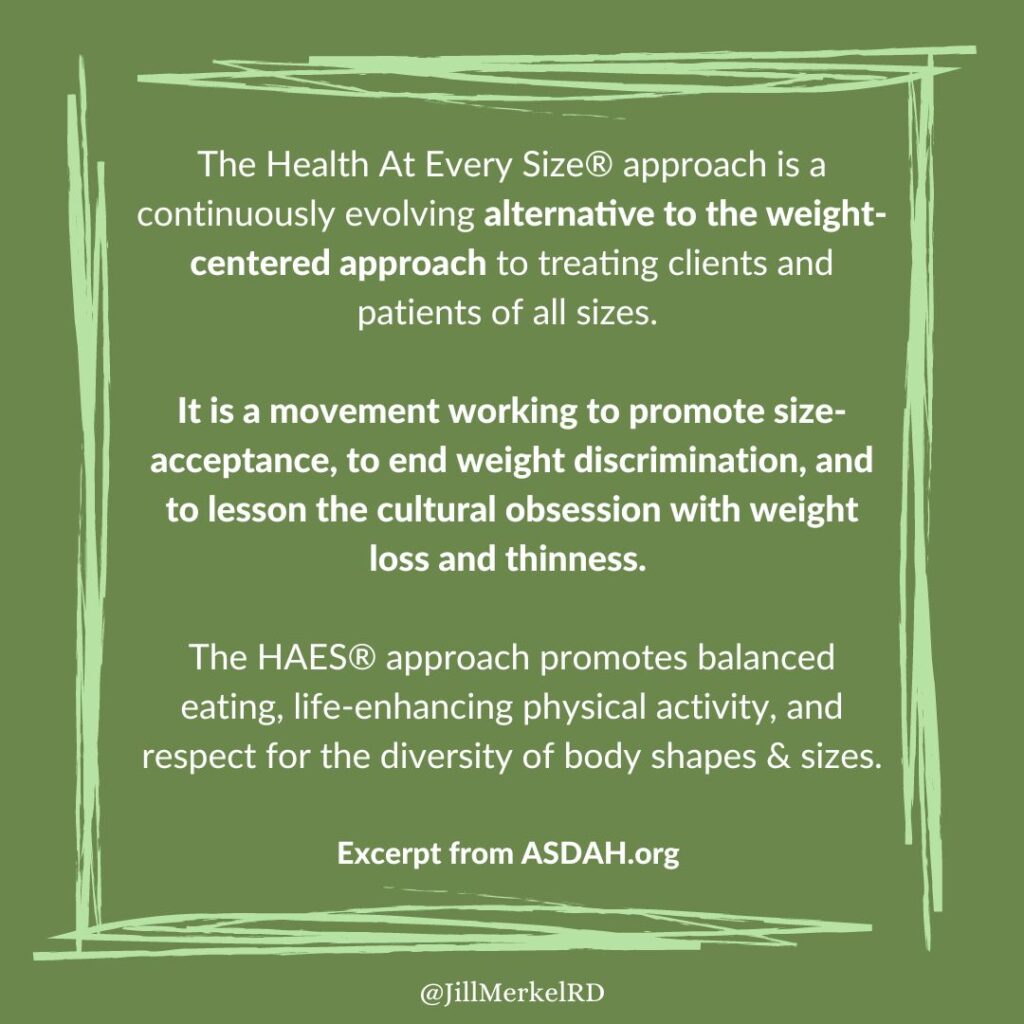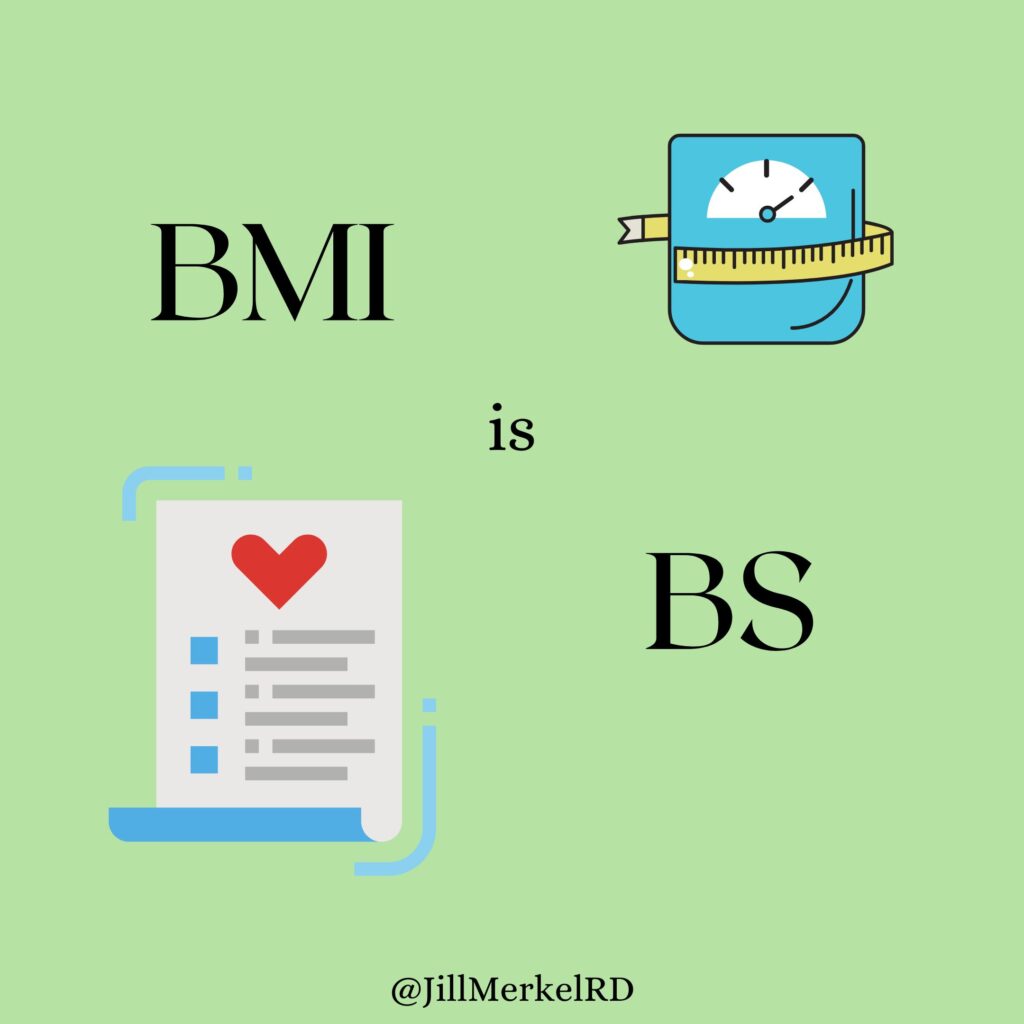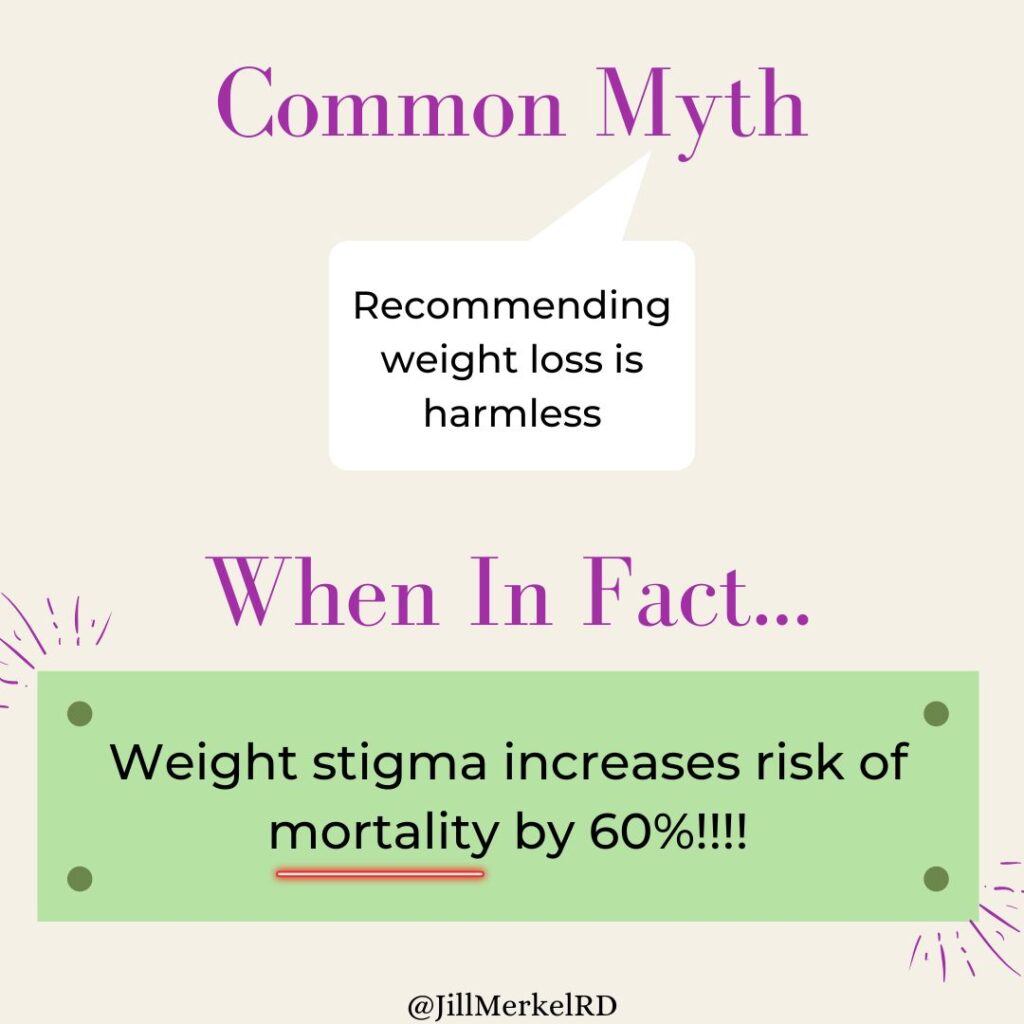Weight inclusive care 101 for healthcare professionals. Why is this post needed? Because sadly, healthcare professionals are still making inaccurate assumptions about fat people and weight-centric providers are co-opting the anti-diet and Health at Every Size® (HAES®) approaches making it hard for patients to know who to trust.
This post is going to look at why weight is not an individual choice and why losing weight is unattainable and unsuccessful for most. And this post is going to provide you with some tools to help you get started in providing weight inclusive care for your patients and clients.
Let’s dive in!

What is Weight Inclusive Care?
Weight inclusive or weight neutral care is practicing from the perspective that everybody deserves equal access to care, and health is independent of weight. This is in direct contrast to the weight centric or weight normative approach, that believes and practices from the perspective that a person’s weight determines their health.

In healthcare, most people are still taught in school and their programs in the weight centric model.
Ragen Chastain describes weight neutral care as care in which people of all sizes who have the same symptoms or diagnoses are given the same interventions, and weight loss is not utilized as a healthcare intervention.
Ragen further describes weight inclusive care as taking things to another level because even if we give fat people the same interventions we give thin people, we are typically still giving interventions developed from research that didn’t include fat people.
Therefore, weight inclusive care is care that is created for bodies of all sizes from the ground up including research, tools, equipment, best practices etc., practiced by fully fat-affirming healthcare practitioners. This one will take longer to institute across the board, but is well worth the time and effort.
Health at Every Size® (HAES®)
The Health At Every Size® approach from The Association for Size Diversity and Health (ASDAH) is a continuously evolving alternative to the weight centered approach to treating clients and patients of all sizes.
It is a movement working to promote size-acceptance, to end weight discrimination, and to lessen the cultural obsession with weight loss and thinness.
The HAES® approach promotes balanced eating, life-enhancing physical activity, and respect for the diversity of body shapes & sizes. HAES® Is associated with improvements in health, including blood pressure, blood lipids, physical activity, and body image.
The HAES® Principles include:
- Weight Inclusivity
- Health Enhancement
- Respectful Care
- Eating for Well-Being
- Life-Enhancing Movement

Their agenda is to shift the focus from weight management to health promotion. HAES® puts the emphasis on health-promoting behaviors rather than solely on weight loss because, as we know by now, weight loss alone does NOT contribute to better health but health-promoting behaviors, regardless of weight loss, does contribute to better health.
HAES® does not mean or say that everyone is healthy at every size, but rather that people can be healthy at a variety of sizes and we really cannot tell anything about someone’s health just by looking at them or knowing their body weight.

Why the Weight Centric Approach Needs To Go
The weight centric approach to healthcare is outdated and harmful. It began with and continues to be based on the very flawed BMI (more on the BMI below).
The weight centric approach incorrectly assumes that everyone in a larger body is unhealthy and everyone in a smaller body is healthy. This allows for and reinforces weight stigma and fatphobia and it is also a very narrow minded view that incorrectly condenses overall health into one factor or metric (weight).
It does not treat the individual or the individual symptoms or issues. There is a lot of weight stigma and bias inherent in the weight centric approach. Therefore, people in larger bodies are not treated the same as people in smaller bodies. They are often misdiagnosed or undiagnosed because the healthcare provider tells them to “simply” lose weight for whatever ailment they are seeking treatment.
The BMI is BS
The Body Mass Index (BMI) was developed in the 1830s by an astronomer. (Note: an astronomer is a scientist who focuses primarily on the study of space, which includes the stars, the planets and the galaxies above us). The BMI was developed as a statistical exercise, and was never intended to be a measure of health or to be used in healthcare.
The BMI equation was developed using an exclusively white, European population and therefore, doesn’t account for differences in body size in other ethnic groups. As Da’Shaun Harrison, author of Belly of the Beast says, “The BMI was created to maintain whiteness as superior.”

Today, the BMI is used by healthcare professionals and insurance companies to determine if someone is “normal weight,” “overweight,” “obese” or “underweight” even though it doesn’t account for age, gender, body composition, ethnicity, race, etc. nor does it accurately predict health outcomes.
It’s simply a way for the weight centric healthcare industry to make more money! If more people are diagnosed as “overweight,”, that means they can bill insurance for and charge for weight-loss “solutions”!
Remember, the diet industry is a HUGE money making industry.
Weight and Health
In our thin obsessed diet culture world, health has become synonymous with weight.
But weight is not a practice or a behavior. It is an outcome that we have much less control over than we’ve been led to believe or that the weight centric model has taught us to believe.
The weight inclusive and the anti-diet approach to nutrition and health allows us to reconnect with ourselves and focus on things that we can control or influence, such as our actions, our mindset, and our effort, IF DESIRED (health is not a requirement for being deserving of respect and care).
And it’s important to remember that you cannot tell anything about someone’s health by looking at them or by their body shape or size. People in all shapes and sizes can be unhealthy or healthy.
The Harms of Weight Cycling
Repeated attempts at weight loss with intermittent periods of weight gain is known as weight cycling or yo-yo dieting.
And ultimately, the most common result of dieting or intentional weight loss is weight cycling, which we know is harmful in many ways:
- Weight cycling results in increased inflammation, which is known to increase risk for many “obesity”-associated diseases
- Other potential mechanisms by which weight cycling contributes to morbidity include hypertension, insulin resistance and dyslipidemia
- Research also indicates that weight fluctuation is associated with poorer cardiovascular outcomes and increased mortality risk
- It may be, therefore, that the association between weight and health risk can be better attributed to weight cycling than adiposity itself
One study found that men with a fluctuating weight (weight cycling) were at an 80 percent higher risk of dying than men who were “overweight.”
Fatphobia and Weight Stigma
Fatphobia (also called anti-fat bias) is prejudice again people in larger bodies. It is the fear and/or hatred of fat bodies and can include a fear of becoming fat or a fear of being fat.
Unfortunately, this has become a cultural norm. We see this all the time in the media – when a celebrity has lost or gained weight and all the comments and attention they get for that.
We’ve likely experienced this in our own lives – either directly or indirectly.
Fatphobia can look like:
- Bullying someone for their size
- Judging someone by their shape/size
- Complimenting people for losing weight
- Expressing concerns for someone in a larger body without knowing anything about their health status
ALL BODIES DESERVE DIGNITY AND RESPECT!
As Alissa Rumsey, author of Unapologetic Eating says, “Fatphobia has never been about health, rather it’s a means to justify race, class, and gender prejudice.”
Weight stigma is the negative attitudes and beliefs about fat folks and the assumptions made based upon their body size. Weight stigma is also a form of discrimination and oppression toward fat people.
Weight stigma includes that fat people have/are:
- Fewer job opportunities
- Lower pay
- Less respect
- Fewer clothing options
- Paying more for health insurance
- Being denied medical care
Sadly, healthcare is one of the most common contexts where weight stigmatization occurs.
An example of weight stigma in healthcare as described in the Intuitive Eating book is of Ellen Maud Bennett. She sought out medical help and no one offered support or suggestions beyond weight loss. When she finally found a doctor who treated her respectfully and fairly, they found she had inoperable cancer and died a few days later.
Understandably, she was pissed. Her dying wish was that women of size make her death matter by advocating strongly for their health and not accepting fat as the only relevant health issue.
Ellen’s story is heartbreaking and unfortunately she is not alone in her experience. Someone in a larger body may go into their doctor for strep throat and are told to lose weight, even though that wasn’t a concern of theirs, nor was it at all relevant to their presenting problem. This can lead people to avoid seeking help because they don’t want to deal with these comments.
Weight stigma ALONE is an independent risk factor for many health problems such as increases in blood pressure, inflammation, stress and depression; lower self-esteem; higher body dissatisfaction; and an increased risk for disease. One study even found that weight stigma increases the risk of mortality by 60%!!

Making assumptions about people in larger bodies is NOT harmless. Unfair treatment on the basis of body weight is stressful. Weight stigma needs to be addressed in our culture, in our healthcare systems, and as a whole rather than continuing to shame and blame certain body shapes and sizes.
How Client Care Looks Different From a Weight Inclusive Approach
Weight inclusive care includes and respects body autonomy, respect, focuses on behaviors, informed consent, and doing no harm.
Weight inclusive care includes and looks like:
- Treating the person and the symptoms
- Believing what the person is telling you
- Focusing on health-promoting behaviors, not outcomes (weight)
- Asking the person how you can help/support them
- Not assuming you know their goals
You may ask yourself:
- What would you tell someone with the same symptoms in a smaller body?
It is not our job as healthcare professionals to “fix” the patient but to work in relationship with them and support them in what is important to them.
{Please note some links in this post are affiliate links. This means if you click on the link and make a purchase, I receive a portion of the sale, at no extra cost to you.}

